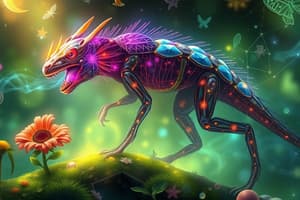Podcast
Questions and Answers
What is classification?
What is classification?
- The study of evolutionary relationships among species
- A way in which living organisms are divided into groups (correct)
- The formation of pairs for breeding
- A scientific practice of grouping organisms based on shared characteristics
What is taxonomy?
What is taxonomy?
Scientific practice of grouping organisms based on shared characteristics.
What does the term 'hierarchical' mean in modern classification systems?
What does the term 'hierarchical' mean in modern classification systems?
Consist of smaller groups within larger groups, no overlap between groups.
What can be inferred from a phylogenetic tree diagram?
What can be inferred from a phylogenetic tree diagram?
How do you know if individuals belong to the same species?
How do you know if individuals belong to the same species?
Why are the cells of a mule, which have 63 chromosomes, unable to undergo meiosis and produce gametes?
Why are the cells of a mule, which have 63 chromosomes, unable to undergo meiosis and produce gametes?
What problems exist in classifying organisms as distinct species?
What problems exist in classifying organisms as distinct species?
How can courtship behavior be used to identify individuals as members of the same or different species?
How can courtship behavior be used to identify individuals as members of the same or different species?
What are the functions of courtship behavior?
What are the functions of courtship behavior?
Why is a courtship song important in successful breeding?
Why is a courtship song important in successful breeding?
What are the ways to investigate genetic diversity?
What are the ways to investigate genetic diversity?
What is a problem in classifying observable characteristics?
What is a problem in classifying observable characteristics?
Why should conclusions about evolutionary relationships from amino acid sequences be treated with caution?
Why should conclusions about evolutionary relationships from amino acid sequences be treated with caution?
What is standard deviation?
What is standard deviation?
Why is standard deviation more valid than range?
Why is standard deviation more valid than range?
How can we use standard deviation to compare two or more sets of data?
How can we use standard deviation to compare two or more sets of data?
Study Notes
Classification and Taxonomy
- Classification divides living organisms into grouped categories based on similarities.
- Taxonomy is the scientific method for grouping organisms, focusing on shared characteristics.
Modern Classification Systems
- Hierarchical systems feature groups within larger groups, ensuring no overlap.
- Phylogenetic systems reflect the evolutionary history of organisms and their relationships.
Phylogenetic Tree Diagrams
- Close branches on a phylogenetic tree indicate a recent common ancestor and stronger evolutionary ties.
Defining Species
- Species are groups of organisms that can interbreed and produce fertile offspring.
- Key criteria for species include the ability to interbreed and produce viable offspring.
Meiosis and Mules
- Mules have 63 chromosomes, which is an odd number, preventing proper meiotic division and gamete formation.
Challenges in Classification
- Life evolved around 3.5 billion years ago; extinct species greatly outnumber living ones.
- Fossil records are often incomplete and don't capture all characteristics.
- Variation within species complicates the definition, particularly for asexual organisms.
Courtship Behavior
- Courtship behaviors are innate and genetically programmed, helping identify species members.
- These behaviors are critical in determining mating capabilities.
Functions of Courtship Behavior
- Recognizes species, synchronizes reproductive actions, identifies suitable mates, forms pair bonds, and prepares for breeding.
Importance of Courtship Songs
- Different species produce unique courtship songs aiding in mate recognition, particularly crucial for nocturnal species and in visually challenging environments.
Investigating Genetic Diversity
- Measures include frequencies of observable traits, DNA base sequences, mRNA sequences, protein amino acid sequences, and immunological techniques.
Limitations of Observational Studies
- Observable traits may be influenced by multiple genes and environmental factors, complicating genetic distinction.
Caution in Amino Acid Sequence Analysis
- Analyzing only short peptide sections can be misleading; similar amino acid sequences do not guarantee identical DNA/RNA base sequences.
Standard Deviation (SD)
- SD measures variability around the mean, giving insight into population variation; lower SD indicates more precise data.
Validity of SD vs. Range
- SD considers all data points and minimizes effects of anomalies, making it a more reliable statistical measure than range.
Comparing Data Sets with SD
- Overlapping SD indicates no significant difference between data sets, while non-overlapping suggests a significant difference.
Studying That Suits You
Use AI to generate personalized quizzes and flashcards to suit your learning preferences.
Description
Test your knowledge on the key concepts of classification and taxonomy in biology with these flashcards. Learn how living organisms are grouped and understand the modern classification systems. Perfect for biology students looking to enhance their understanding of these fundamental topics.




